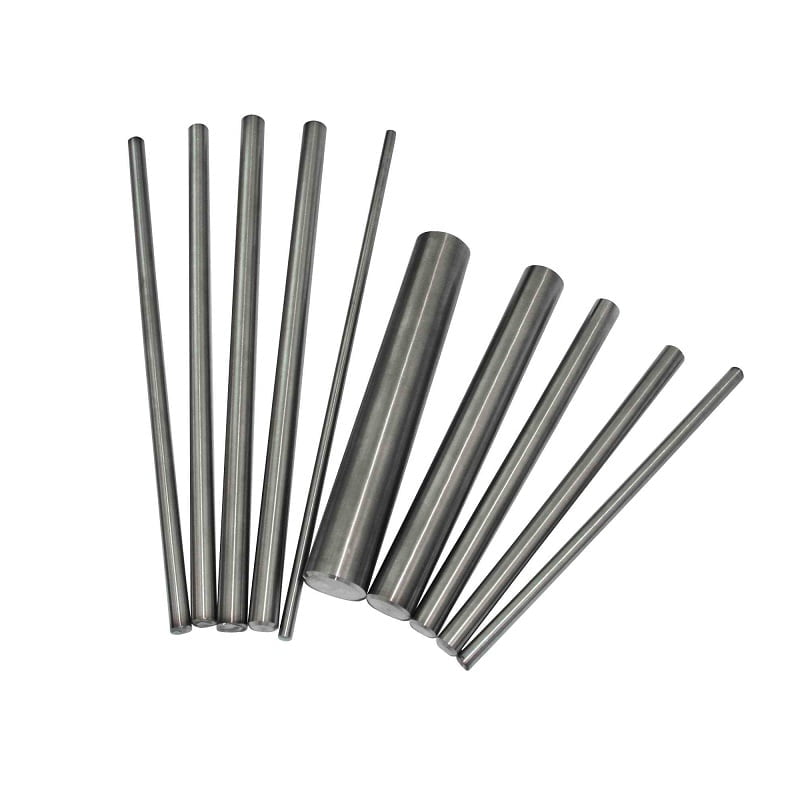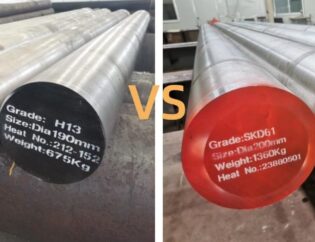
El acero sigue siendo uno de los materiales más versátiles y utilizados en aplicaciones de ingeniería y fabricación debido a su resistencia, durabilidad y adaptabilidad. Entre los numerosos grados disponibles, 12L14 y 1045 Hay dos tipos notables que satisfacen diferentes necesidades. Este documento proporciona una comparación completa de estos dos aceros, explorando sus composiciones químicas, propiedades mecánicas, aplicaciones, capacidades de tratamiento térmico, soldabilidad, costos y más.
Descripción general del acero 12L14
El 12L14 es un acero con bajo contenido de carbono conocido por su excepcional maquinabilidad, principalmente debido a sus elementos de aleación específicos, incluidos el plomo y el azufre. La calidad se utiliza normalmente en aplicaciones donde el mecanizado de precisión es esencial, lo que la convierte en una de las favoritas entre ingenieros y maquinistas.
Composición química del 12L14
La composición química del acero 12L14 es crucial para comprender sus propiedades y comportamiento durante el procesamiento. La composición típica es la siguiente:
| Elemento | Composición (%) |
|---|---|
| Carbono (C) | ~0,12% |
| Manganeso (Mn) | ~0,60% |
| Fósforo (P) | ~0,04% |
| Azufre (S) | ~0,26% |
| Plomo (Pb) | ~0,15% |
La presencia de plomo actúa como ayuda al mecanizado mejorando la formación de viruta y reduciendo el desgaste de la herramienta.
Propiedades mecánicas del 12L14
Las propiedades mecánicas del acero 12L14 lo hacen adecuado para diversas aplicaciones. Algunas propiedades clave son:
| Propiedad | Valor |
|---|---|
| Fuerza de Tensión | 58 000 – 75 000 psi |
| Fuerza de producción | Aproximadamente 38.000 psi |
| Dureza | Aproximadamente 85 HRB |
| Maquinabilidad | Excelente |
El bajo contenido de carbono proporciona suficiente resistencia para muchas aplicaciones de baja tensión y al mismo tiempo permite un fácil mecanizado.
Aplicaciones del acero 12L14
Debido a su maquinabilidad, el 12L14 se usa comúnmente en aplicaciones que requieren alta precisión. Algunas aplicaciones comunes incluyen:
| Tipo de aplicación | Descripción |
|---|---|
| Piezas mecanizadas de precisión | Se utiliza en componentes que requieren tolerancias estrictas, como ejes y accesorios. |
| Sujetadores | Se utiliza para pernos, tornillos y sujetadores similares debido a su rentabilidad y facilidad de mecanizado. |
| Engranajes | Comúnmente utilizado para engranajes de baja carga en diversas maquinarias. |
| Componentes hidráulicos | Ideal para accesorios hidráulicos donde se necesitan tolerancias constantes. |
Descripción general del acero 1045
1045 es un acero de medio carbono que proporciona mayor resistencia y dureza en comparación con el 12L14. Este grado de acero es muy adecuado para aplicaciones de uso general y se beneficia de procesos de tratamiento térmico que mejoran aún más sus propiedades.
Composición química de 1045
La composición química del acero 1045 está más enfocada a lograr mayor resistencia y dureza. La composición suele incluir:
| Elemento | Composición (%) |
|---|---|
| Carbono (C) | ~ 0,45% |
| Manganeso (Mn) | 00,60 – 0,90% |
| Fósforo (P) | ≤0,04% |
| Azufre (S) | ≤0,05% |
El mayor contenido de carbono aumenta significativamente la dureza y la resistencia a la tracción del material.
Propiedades mecánicas de 1045
Las propiedades mecánicas del acero 1045 son las siguientes:
| Propiedad | Valor |
|---|---|
| Fuerza de Tensión | 85.000 – 100.000 psi |
| Fuerza de producción | Aproximadamente 65.000 psi |
| Dureza | Aproximadamente 90 HRB o más |
| Maquinabilidad | Moderado |
Con mayor carbono y manganeso, el 1045 presenta un mejor rendimiento bajo tensión y una resistencia al desgaste mejorada que el 12L14.
Aplicaciones del acero 1045
El acero 1045 es adecuado para una variedad de aplicaciones debido a sus deseables propiedades mecánicas. Las aplicaciones comunes incluyen:
| Tipo de aplicación | Descripción |
|---|---|
| Ejes | Se utiliza en ejes de transmisión de potencia que requieren buena resistencia y resistencia a la torsión. |
| Engranajes | Eficaz para engranajes de alto par, a menudo sujetos a tratamiento térmico para mayor durabilidad. |
| Cigüeñales | Comúnmente utilizado en aplicaciones automotrices donde la resistencia y la dureza son críticas. |
| Sujetadores de alta resistencia | Ideal para aplicaciones que exigen alta resistencia a la tracción. |
Comparación de maquinabilidad
La maquinabilidad es un factor crítico que a menudo influye en la elección entre acero 12L14 y 1045.
| Rasgo | Acero 12L14 | 1045 Acero |
|---|---|---|
| Facilidad de mecanizado | Excelente debido al contenido de plomo; permite velocidades de corte más rápidas y un menor desgaste de la herramienta. | Moderado; El mecanizado puede ser un desafío, especialmente en condiciones de tratamiento térmico. Requiere herramientas más afiladas y técnicas precisas. |
El plomo agregado al 12L14 ayuda a producir superficies de corte más suaves y prolonga la vida útil de la herramienta, mientras que el 1045 requiere más cuidado durante el mecanizado.
Capacidades de tratamiento térmico
Los procesos de tratamiento térmico permiten que tanto el 12L14 como el 1045 alcancen las propiedades mecánicas deseadas; sin embargo, sus respuestas al tratamiento térmico difieren significativamente.
| Rasgo | Acero 12L14 | 1045 Acero |
|---|---|---|
| Tratamiento térmico | Generalmente no tratado térmicamente; Se utiliza en estado laminado, lo que es suficiente para aplicaciones de baja tensión. | Puede someterse a tratamientos térmicos como templado y revenido para mejorar sustancialmente la dureza y la resistencia a la tracción. |
La capacidad del 1045 para recibir tratamiento térmico lo convierte en una opción versátil para aplicaciones exigentes, mientras que el 12L14 mantiene sus propiedades en su estado original.
Soldabilidad
La soldabilidad es otro factor importante a considerar al elegir entre estos dos materiales.
| Rasgo | Acero 12L14 | 1045 Acero |
|---|---|---|
| Características de soldadura | No recomendado para soldadura debido al contenido de plomo, que puede provocar una mala integridad de la soldadura. | Se puede soldar con cuidado; Puede ser necesario precalentar para evitar el agrietamiento debido al contenido medio de carbono. Los materiales de relleno adecuados son esenciales para obtener soldaduras fuertes. |
La falta de soldabilidad en 12L14 a menudo requiere cambios de diseño para evitar la soldadura por completo.
Costo y disponibilidad
El costo y la disponibilidad a menudo juegan un papel crucial en la selección de materiales.
| Rasgo | Acero 12L14 | 1045 Acero |
|---|---|---|
| Costo | Normalmente son más caros que los aceros normales con bajo contenido de carbono debido a los elementos de aleación, pero pueden surgir ahorros gracias a la eficiencia del mecanizado. | Generalmente menos costoso y ampliamente disponible; una opción popular para diversas aplicaciones debido a sus propiedades versátiles. |
La disponibilidad del 1045 en múltiples formas (barras, placas, láminas) a menudo lo convierte en la opción más económica para aplicaciones a gran escala.
Resumen y conclusión
En conclusión, la elección entre acero 12L14 y 1045 dependerá en última instancia de los requisitos específicos del proyecto.
| Rasgo | Acero 12L14 | 1045 Acero |
|---|---|---|
| Atributos primarios | Excelente maquinabilidad, bajo contenido de carbono. | Mayor resistencia y versatilidad en el tratamiento térmico. |
| Composición química | Bajo en carbono; el plomo mejora el mecanizado | Medium carbon; enhances hardness & strength |
| Propiedades mecánicas | Resistencia moderada a la tracción y al límite elástico. | Mayor resistencia a la tracción y dureza. |
| Aplicaciones | Piezas de precisión, sujetadores, componentes hidráulicos. | Ejes, engranajes, componentes de automoción. |
| Maquinabilidad | Superior debido al contenido de plomo | Moderado, mejor con las herramientas adecuadas |
| Tratamiento térmico | Normalmente no se trata térmicamente | Tratable térmicamente para mejorar las propiedades. |
| Soldabilidad | No apto para soldar | Se puede soldar con técnicas adecuadas. |
| Costo y disponibilidad | Materiales de mecanizado especializados de mayor coste | Más económico, ampliamente disponible |
Al comprender las diferencias entre estos dos grados de acero, los fabricantes pueden tomar decisiones informadas que se alineen con las especificaciones de su proyecto y los requisitos de rendimiento. Si hay temas más específicos o se necesitan más aclaraciones sobre el acero 12L14 y 1045, ¡no dude en preguntar!

